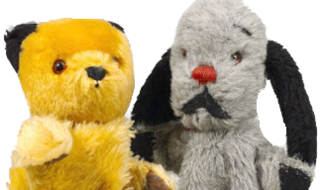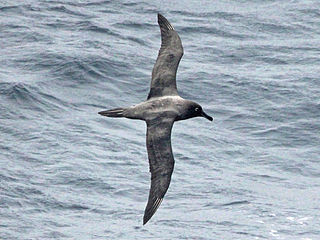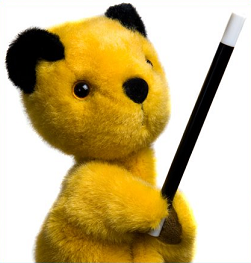
The great shearwater is a large shearwater in the seabird family Procellariidae. Ardenna was first used to refer to a seabird by Italian naturalist Ulisse Aldrovandi in 1603, and gravis is Latin for "heavy".

The sooty shearwater is a medium-large shearwater in the seabird family Procellariidae. Ardenna was first used to refer to a seabird by Italian naturalist Ulisse Aldrovandi in 1603, and grisea is medieval Latin for "grey".

The sooty tern is a seabird in the family Laridae. It is a bird of the tropical oceans, breeding on islands throughout the equatorial zone.
Gullane Entertainment Limited was a British independent production company which produced children's programming, including Thomas & Friends, Shining Time Station and The Magic Adventures of Mumfie, as well as the film Thomas and the Magic Railroad. The company today is an in-name only subsidiary of HIT Entertainment and an IP holder for Thomas & Friends.

The sooty falcon is a medium-sized falcon breeding from northeastern Africa to the southern Persian Gulf region.

Sweep is a British puppet and TV character popular in the United Kingdom, United States, Canada, Australia, Ireland, New Zealand and other countries.

Sooty mold is a collective term for different Ascomycete fungi, which includes many genera, commonly Cladosporium and Alternaria. It grows on plants and their fruit, but also environmental objects, like fences, garden furniture, stones, even cars. The mold benefits from either a sugary exudate produced by the plant or fruit, or if the plant is infested by honeydew-secreting insects or sap suckers.

The sooty albatross, dark-mantled sooty albatross or dark-mantled albatross,, is a species of bird in the albatross family. They breed on sub-Antarctic islands and range at sea across the Southern Ocean from South America to Australia.

The sooty oystercatcher is a species of oystercatcher. It is a wading bird endemic to Australia and commonly found on its coastline. It prefers rocky coastlines, but will occasionally live in estuaries. All of its feathers are black. It has a red eye, eye ring and bill, and pink legs.

The greater sooty owl, is a medium to large owl found in south-eastern Australia, Montane rainforests of New Guinea and have been seen on Flinders Island in the Bass Strait. They have a finely white spotted head with scattered white spots on the wings. The females are lighter colored than the males. The females' length is 37–43 cm and weighs 750-1200 g. The male is smaller and length is 37–43 cm and weighs 500-700 g. The wing length is 30–40 cm. The large dark eyes are set in a round large facial disk. The facial disk is dark gray-silver or sooty black and has a heavy black edge. The upper part of the owl is black to dark gray and the under part is lighter. The tail is short and the legs are feathered. The feet and talons are large. Their call is a piercing shriek which can last up to two seconds.
The lesser sooty owl, is sometimes considered to be conspecific with this species, in which case they are then together referred to as sooty owls. It is substantially smaller and occurs in the wet tropics region of North Queensland, Australia.

The spectacled tern, also known as the grey-backed tern, is a seabird in the family Laridae.

"The pot calling the kettle black" is a proverbial idiom that may be of Spanish origin of which English versions began to appear in the first half of the 17th century. The idiom is glossed in the original sources as being used of a person who is guilty of the very thing of which they accuse another and is thus an example of psychological projection.

Nothofagus solandrivar.solandri, commonly called Black beech, is a variety of the tree species Nothofagus solandri, endemic to New Zealand. Black beech occurs on both the North and the South Island at low altitudes up to the mountains. The other variety of N. solandri is called Mountain beech or Nothofagus solandri var. cliffortioides, and grows at higher altitudes than black beech. In New Zealand the taxon is called Fuscospora solandri.

The black-and-white owl is a species of owl in the family Strigidae.

Capnodiales is a diverse order of Dothideomycetes, initially based on the family Capnodiaceae, also known as sooty mold fungi. Sooty molds grow as epiphytes, forming masses of black cells on plant leaves and are often associated with the honeydew secreted by insects feeding on plant sap. This diverse order has been expanded by the addition of several families formerly thought unrelated and now also includes saprobes, endophytes, plant pathogens, lichens and rock-inhabiting fungi. The new additions include the genus Mycosphaerella containing the causal agents of several economically important crop and tree diseases. A small number of these fungi are also able to parasitise humans and animals, including species able to colonise human hair shafts.

A horse coat color that has the Sooty trait is characterized by black or darker hairs mixed into a horse's coat, typically concentrated along the topline of the horse and less prevalent on the underparts. Sootiness is presumed to be an inherited trait, though the precise genetic mechanism, or series of mechanisms, is not well understood.

Sooty is a glove puppet television, stage, comic book and film character, who is a small yellow male bear with black ears and nose who likes to perform magic tricks and play practical jokes. Although mute to the audience, he is said to be able to communicate by 'whispering' in the ear of his handler. He was created by the puppeteer, magician and pianist Harry Corbett in 1948. Sooty debuted on local television in 1952, and the children's television shows that bear his name have continued in various forms since 1955 and, according to Guinness World Records, is the longest-running continuing children's programme in the UK, with 857 episodes being aired as of 30 October 2018.

Seal brown is a hair coat color of horses characterized by a near-black body color; with black points, the mane, tail and legs; but also reddish or tan areas around the eyes, muzzle, behind the elbow and in front of the stifle. The term is not to be confused with "brown", which is used by some breed registries to refer to either a seal brown horse or to a dark bay without the additional characteristics of seal brown genetics.

The sooty grunter, also known by the name black bream, is a species of fish which inhabits coastal and inland freshwater creeks and rivers of northern Australia: from the upper Burdekin River in Queensland to the Daly River in the Northern Territory.



















